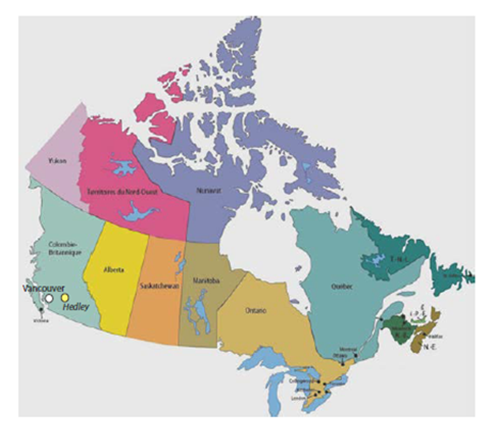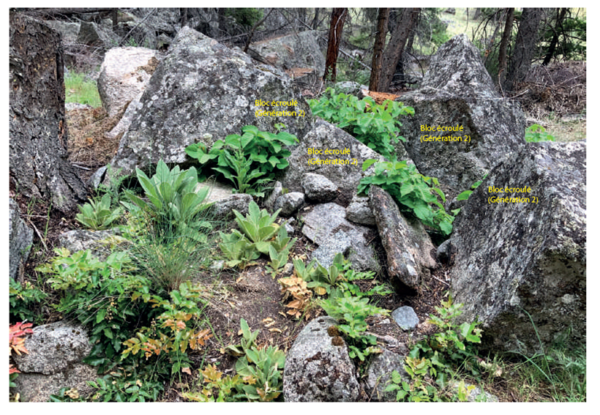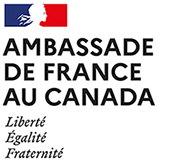A French-Canadian scientific consortium, supported by the Upper Similkameen Indian Band, the Ministry of Europe and Foreign Affairs and the University of British Columbia, is undertaking archaeological excavations at the Chuchuwayha site in British Columbia
Introduction
Since 2015, a group of French and Canadian researchers has been studying the Chuchuwayha site in British Columbia, to rebuild the history of human occupation and the associated preserved arts history, and then to extend this knowledge to the entire region. An anthropological dimension is added to this historic objective, in as much as the project brings together French scientific expertise, Canadian institutions such as the Museum of Anthropology (MoA) of Vancouver and the Upper Similkameen Indian Band community. Therefore, it is a multi-scalar and multidisciplinary project combining archaeology, ethnoarchaeology, anthropology, archaeomaterials science, and geosciences.
Archaeological and cultural context behind the research project
1/ Rock art in British Columbia, linked for the culture of the First Nations
British Columbia is particularly rich in terms of parietal rock art, with at least 500 sites identified. Nonetheless, it is only since the 1990s than archaeological studies has been conducted there, especially on the Upper Similkameen Indian Band (USIB) territories. For instance, excavations led in 1998-1999 established that the region had been occupied for 10,000 years. However, those studies had mainly focused on the landscapes surrounding the rock sites; thus, little information is currently available about the chronology of human occupation and ochre pictographs on these sites. The rock art characteristic of these archaeological sites has always been strongly associated with First Nations culture, for its ritual and social functions.
2/ Description of the rock sites studied
The French-Canadian research project currently involves two archaeological sites located on the Indian Band territories on the Nicola and Similkameen Rivers, including the Upper Similkameen Indian Band territory.
The first and main one is the Chuchuwayha rock shelter, near Hedley, in British Columbia. The archaeological device currently visible is composed by several dozen of red pictographs of various shades with symbolic, abstract or figurative patterns, as well as semi-buried and fitted out habitat structures. This site preserved the physical, natural and anthropic events which marked its evolution, events the project researchers plan to rebuild.
The second is Jameson Flats, located on the opposite bank to Chuchuwayha. It is a collapsed boulder, forming a rock shelter preserving three types of rock drawings: two curved lines arranged vertically in parallel, a standing bird – an unusual representation in the region – motifs in the form of a cross and traces of recent use of the site.
Finally, the entire the surroundings of the Chuchuwayha site is also being studied to understand the main morphological characteristics of the Similkameen River valley, its formation and its landscape evolution over time and to tie it to the periods of human occupation. At the same time, investigations are also carried out at the Ochre Bluffs site (Tulameen) to try to identify the source of the pictograph ochres mentioned above.

Localization of the Chuchuwayha site
Objectives of the project
1/ The sources of the research project
In 2015, the Hedley First Nations community made a request to broaden the archaeological knowledge of the Chuchuwayha site and its rock art. In September 2015, Professor Jean-Michel Geneste, General Curator of French Honorary Heritage, was invited by the Post as part of the French Scholars Lecture Series program. During this first visit, Jean-Michel Geneste visited the highlights of British Columbia’s rock art, mainly in First Nations reserves, which had a strong protocol dimension. He met formally with chiefs and tribes representatives to highlight the cultural issues involved in the preservation of sacred sites. He also gave a lecture entitled Predator and prey: the art of Chauvet and participated in a symposium organised at the MoA. As a result of this visit, four projects were considered in view of the strong potential for scientific and cultural cooperation revealed by this meeting. The structure, terms and precise objectives of the project were defined, while respecting the myths and beliefs of the USIB community. The project’s main purpose is to preserve this cultural heritage and to produce educational tools for the First Nations and the general public. Thus, the initial project included:
- Archaeological and geomorphological research around the Chuchuwayha site
- A program of scientific publications;
- The production of documentation for the communities of the region;
- The organization of an exhibition on the history of human occupation in the Similkameen region, confronted with the work of contemporary artists, at MOA;
- The constitution of a research and archive documentation, in connection with and for the USIB;
- The production of an audiovisual documentary on the excavations.
2/ The building of the French-Canadian partnership
The research team is composed of a Franco-Canadian consortium, members of the USIB community, members of the University of British Columbia (UBC), mainly from the Museum of Anthropology and the Archaeology Laboratory, archaeologists working with the USIB, and French researchers from the French Institute of Oriental Archaeology and from the Edytem laboratory, located at the University of Savoie Mont Blanc.
The main French participants of the project are the following:
- Anita Quiles, head of the archaeometry pole of the French Institute of Oriental Archaeology in Cairo, project leader;
- Jean-Michel Geneste, General Curator of Honorary Heritage, former Director of the National Centre for Prehistory;
- Jean-Jacques Delannoy, professor of geomorphology at the University of Savoie Mont-Blanc, member of the Institut universitaire de France, involved in the study of the physical context of caves and decorated sites.
As for Canadian participants, the main ones are:
- Mike Allison, site owner and councilor for the Upper Similkameen Indian Band
- Susan Rowley, Associate Professor in the Department of Anthropology and Curator of Public Archaeology at UBC MoA;
- Brenda Gould, Chair of Similkameen Consulting: Contract Archaeologist and Heritage resource management specialist and post graduate certificate in Heritage resource management from Simon Fraser University;
- Angela Clyburn, specialist in the research, location, recording and digitisation of rock art sites.
The partnership initiated in 2015 has been renewed in 2019 through a four-year Memorandum of Understanding signed between UBC, USIB, the French Institute of Oriental Archaeology in Cairo and the Université Savoie Mont-Blanc.
3/ Research axes
The aim of the project is to define a complex chronological framework of the cultural levels identified during the excavations, and of the associated rock art. The research team is therefore seeking to deepen the history of northwestern Canada by reconstructing the temporalities of the use and evolution of the above-mentioned sites. In the long term, the project appears to be a means of better understanding the interactions between Nature and Man in the Similkameen Valley, the periods of human use of the site, to link them with the rock art preserved in British Columbia, and to disseminate this knowledge to the general public. The ultimate goal is to help the USIB to better reappropriate their history, to highlight the culture of the First Nations, which is sometimes little known, and to support the associated cultural diversity.
Three lines of research have been invested in order to carry out this archaeological mission.
Firstly, the use of natural archives. This involves making sedimentary records of the Chuchuwayha rock shelter in order to study, on the one hand, regional events (geology, climate, environment) and, on the other hand, local phenomenon that have affected the walls (collapse, readjustments, sheddings), and to reproduce the palaeo-landscapes with which the people who frequented the site were confronted. Such sedimentological and granulometric analyses enable to establish a correlation between archaeological phases and climatic environments. In addition, archaeozoological and archaeobotanical studies provide comparative data for reconstructing the paleoenvironments of the site.
Then there is the study of the ground archives. This is the study of the archaeological material strictly speaking, obtained during the excavations, which includes:
- The study of the tangible culture, and especially the lithic tools, to place chronologically the occupations, the origins of the population movements, or yet the belonging to the cultural movements identified in the geographical areas of the northwestern American continent;
- The direct dating of organic artefacts, to determine the frequentation phases of the site;
The use of ground archives will eventually allow us to determine when the first traditional communities implanted themselves and to establish the USIB community’ ethnological and archaeological relations.
Thus, the study of the red pictographs, to constrain more precisely in time the rock arts phases of realization. For this, three approaches are considered:
- Defining the decorated surfaces’ setting based on the geomorphological approach and the dating by cosmogenics.
- Amongst the pictographs, those exposed to the weather and the external environment are covered with silico-calcic crusts which can cover or rest on the pictographs. The dating of these deposits enables the determination of the age of the pictographs.
- Moreover, the archaeometric investigations, carried out on the colouring materials diversity used on the Chuchuwayha site, contribute to identifying potential sources of supply for the site.
The project’s implementation
1/ The funding
Since 1990, there has been a France-Canada agreement for cooperation and exchanges in the field of museums. This agreement aims to establish and maintain privileged and lasting ties between French and Canadian museum institutions, to improve the skills of museum professionals, and to optimize the implementation of Franco-Canadian projects. In concrete terms, this agreement offers a financial contribution to the implementation of cooperation and exchange projects, although this contribution does not cover all expenses. Moreover, on the French side, the project funding mainly comes from the Ministry of Europe and Foreign Affairs Commission des fouilles (MEAE, 2019-2022), the Consulate General of France in Vancouver (since 2016) and the Edytem laboratory of the Savoie Mont-Blanc University.
On the Canadian side, the USIB, the Similkameen Consulting Company and UBC via the MoA and the archaeology laboratory also contribute to the research funding.
2/ Realization stages
It was in 2016, from 7 to 31 May, during a second operational visit, that the projects defined in 2015 took shape. Two weeks of archaeological excavations were set, the results of which confirmed the need to engage in a multidisciplinary research program. The screening and discussion of the film “Le dernier passage”, directed by Pascal Magontier, took place.
In 2017, a symposium on rock art was held in Lytton. Organised by the Nlaka’Pamux Tribal Council, it gathered French and Canadian specialists around several round tables open to the public. This was the first international conference on rock art organized by First Nations in North America, as well as the first time seven Indian Band leaders were together.
In 2018, the second archaeological mission to the Chuchuwayha site was conducted. To define the history morphology and occupation of the site and understand the presence of anthropic structures, priority was given to field actions during this mission. Thus, the following were carried out:
- An archaeological excavation at the foot of the decorated walls and the collection of archaeological material for analysis (lithic, wildlife, 14C dating)
- A mapping of the morphogenic context of the site (glacial shaping…);
- An anthropo-geomorphological mapping of the archaeological site and its surroundings;
- Sampling of the silico-calcareous crusts (tuffs and wall veils) to date the pictographs;
- Sampling of blocks on the ground and in the rock face;
- A granulometric and morphoscopic analysis of the sediments from the excavations.
To complete this fieldwork, a 3D acquisition of the physical context of the site and the archaeological excavations were carried out, with a view to proposing 3D animations of the site evolution once this was established.

Example of the anthropic structures observed in Chuchuwayha
In 2019, a third long-term archaeological mission was held. Two hundred and eighty-nine units from the Chuchuwayha site were excavated from 28 April to 17 May, while the Jameson Flats site was excavated on 10 and 11 May. These excavations focused on archaeological material (lithic material and artefacts), on the study of the ash level within the sediments (which enabled the hypothesis of a catastrophic event such as a volcanic eruption during the site history), on the pictographs and their encrustations, as well as on a geomorphological study to describe the topographical evolutions of the Similkameen valley.
Due to the international health crisis, no fieldwork was possible in 2020, so the research team focused on the study of the archaeological material collected during the previous campaigns. The archaeobotanical and archaeozoological material is still under investigation. The granulometric and morphoscopic analyses were pursued, enabling to put forward hypotheses on the placement of the fine sediments, in particular the hypothesis of an input of eolian sediments. The goal in 2020 was therefore specifically to specify the topographical and morphogenic characteristics of the physical environment surrounding the site by working at the regional, valley and slope scales. The research teams also studied the ways in which the valley froze and un-froze during the last cold period, to establish a first evolutionary scenario for the structuring of the surroundings of the Chuchuwayha site.
3/ The results
This research project first and primary objective was to establish the chronological history of the Chuchuwayha site and its surroundings. In fact, the first fieldworks conducted by the present team showed that the Chuchuwayha site was an essential chrono-cultural milestone in understanding British Columbia archaeological history. Following the 2019 archaeological excavation, it was concluded that human occupation of the site were at least 5,000 years old, as evidenced by 14C dating of organic artefacts collected in association with lithic and wildlife material. Moreover, sedimentological studies confirmed the existence of a homogeneous compact ash level that marks a major and ancient catastrophic event in the region, interpreted as linked to the eruption of Mount Saint Helen more than 3500 years ago, which necessarily impacted the lives of humans and their vegetable and animal environment. The analyses carried out in 2020 enabled the researchers to establish a first chronological scenario and to complete their initial knowledge, since they managed to characterize the sedimentary sequence and to place the elementary units in the stratigraphic section of the site. The site occupation would therefore be at least 5000 years old and would have been continuous until the catastrophic event of the eruption of Mount Saint Helen, leading to a phase of abandonment of the site by humans for a period of 100 to 1000 years. Following this, human presence was again observed until around 1300 years ago, although this is not the definitive end of the site’s use. These chronological boundaries will be clarified by additional 14C analyses currently underway (samples taken during the 2022 mission), which will enable to further specify the chronological model of the site’s use. Then, the morphogenic and palaeogeographic contextualisation studies of the Chuchuwayha site have made it possible to establish the main stages in the site development and its immediate environment. There would have been an initial phase of disengagement from the middle Similkameen valley, followed by a phase of profound modifications of the physical framework of the valley, enabling the final structuring of the site.
The second objective of this project was to understand the importance of the Chuchuwayha site and its surroundings for the First Nations people who frequented it. On the one hand, the anthropo-geomorphological study of the archaeological site revealed the presence of anthropic origin traces, such as a slight depression with a pebble-covered bottom and depressions surrounded by granite blocks. These depressions bear witness to anthropic uses and structures of as yet unknown function. On the other hand, it has been interpreted that the Chuchuwayha shelter, given its parietal device and its previous arrangements in the sheltered area such as ancient tomb imprints, possessed a form of sacredness. Moreover, the diversity of organic remains, the multiplicity of occupation phases, testifying a variation of the space modes of occupation, type of residence, groups mobility, and the numerous areas of combustion suggest that this site was a residential area with an abundant operation of domestic and/or ritual fires. However, if the site sacred function and ritual activities seem essential, they are not exclusive. Actually, it would seem that the site initially experienced a period of low frequentation related to economic rather than sacred activities. Then, the Jameson Flats site appears to have been intensively and/or regularly occupied as a place of regular passage for hunters equipped with various styles weapons and projectiles, but probably over more recent periods. Thus, it probably consisted of some form of hunting halt, although its function remains to be investigated in depths.
Pursuit and perspectives
For 2021 and 2022, it was considered to continue the archaeological and geomorphological study of the site and to identify new potential excavation sites. In addition, the cross-dating approaches using carbon-14, cosmogenic and U-Th, and the archaeometric study of the colouring materials for the pictographs will be continued. In particular, in October 2021, wall samples were taken, in agreement with the site owners, to carry out cosmogenic dating, which will help to determine the block collapse periods that modified and constrained the ancient landscape. Then, the video recordings of the research will be used to create an educational, archiving and spread knowledge documentary. This project has a strong cultural dimension, linked with the traditional communities involved and owners of the sites and the material unearthed. Such a research and archive document will also enable the editing and production of other documents for universities, researchers and the general public. The aim is thus to create a multi-user scientific and cultural mediation product.
Moreover, multiple actions with Canada are planned to deepen the quality of the partnership. First and foremost with the First Nations, through enhancement projects considered in collaboration with them, with a view to sharing them with the communities. The social and human dimension of the project will thus be strengthened through a strong collaboration with the First Nations members. Secondly, with the MoA, which finds interest in this research project in that it represents a multiplatform concept, with a diversity of institutions and disciplines. In addition, the collaborations with Canadian laboratories and their researchers are strengthened, especially those from the First Nations, to ensure that the maximum number of post-excavation studies are carried out in Canada. Furthermore, to ensure these projects, the French Embassy in Canada confirmed the upholding of its financial support for the pursuit of the research.

